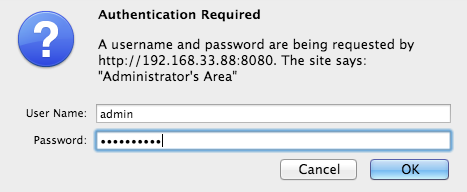Restricting Access with HTTP Basic Authentication (original) (raw)
- Home
- F5 NGINX Plus
- Admin Guide
- Security Controls Restricting Access with HTTP Basic Authentication
You can restrict access to your website or some parts of it by implementing a username/password authentication. Usernames and passwords are taken from a file created and populated by a password file creation tool, for example, apache2-utils.
HTTP Basic authentication can also be combined with other access restriction methods, for example restricting access by IP address or geographical location.
- F5 NGINX Plus or NGINX Open Source
- Password file creation utility such as
apache2-utils(Debian, Ubuntu) orhttpd-tools(RHEL/CentOS/Oracle Linux).
To create username-password pairs, use a password file creation utility, for example, apache2-utils or httpd-tools
- Verify that
apache2-utils(Debian, Ubuntu) orhttpd-tools(RHEL/CentOS/Oracle Linux) is installed. - Create a password file and a first user. Run the
htpasswdutility with the-cflag (to create a new file), the file pathname as the first argument, and the username as the second argument:
sudo htpasswd -c /etc/apache2/.htpasswd user1 sudo htpasswd -c /etc/apache2/.htpasswd user1 Press Enter and type the password for user1 at the prompts.
3. Create additional user-password pairs. Omit the -c flag because the file already exists:
sudo htpasswd /etc/apache2/.htpasswd user2 sudo htpasswd /etc/apache2/.htpasswd user2 - You can confirm that the file contains paired usernames and hashed passwords:
shell
$ cat /etc/apache2/.htpasswd
user1:$apr1$/woC1jnP$KAh0SsVn5qeSMjTtn0E9Q0
user2:$apr1$QdR8fNLT$vbCEEzDj7LyqCMyNpSoBh/
user3:$apr1$Mr5A0e.U$0j39Hp5FfxRkneklXaMrr/ $ cat /etc/apache2/.htpasswd
user1:$apr1$/woC1jnP$KAh0SsVn5qeSMjTtn0E9Q0
user2:$apr1$QdR8fNLT$vbCEEzDj7LyqCMyNpSoBh/
user3:$apr1$Mr5A0e.U$0j39Hp5FfxRkneklXaMrr/ Configuring NGINX and NGINX Plus for HTTP Basic Authentication
- Inside a location that you are going to protect, specify the auth_basic directive and give a name to the password-protected area. The name of the area will be shown in the username/password dialog window when asking for credentials:
nginx
location /api {
auth_basic "Administrator’s Area";
#...
} location /api {
auth_basic "Administrator’s Area";
#...
} - Specify the auth_basic_user_file directive with a path to the .htpasswd file that contain user/password pairs:
nginx
location /api {
auth_basic "Administrator’s Area";
auth_basic_user_file /etc/apache2/.htpasswd;
} location /api {
auth_basic "Administrator’s Area";
auth_basic_user_file /etc/apache2/.htpasswd;
} Alternatively, you you can limit access to the whole website with basic authentication but still make some website areas public. In this case, specify the off parameter of the auth_basic directive that cancels inheritance from upper configuration levels:
nginx
server {
...
auth_basic "Administrator’s Area";
auth_basic_user_file conf/htpasswd;
location /public/ {
auth_basic off;
}
}server {
...
auth_basic "Administrator’s Area";
auth_basic_user_file conf/htpasswd;
location /public/ {
auth_basic off;
}
}Combining Basic Authentication with Access Restriction by IP Address
HTTP basic authentication can be effectively combined with access restriction by IP address. You can implement at least two scenarios:
- a user must be both authenticated and have a valid IP address
- a user must be either authenticated, or have a valid IP address
location /api {
#...
deny 192.168.1.2;
allow 192.168.1.1/24;
allow 127.0.0.1;
deny all;
} location /api {
#...
deny 192.168.1.2;
allow 192.168.1.1/24;
allow 127.0.0.1;
deny all;
} Access will be granted only for the 192.168.1.1/24 network excluding the 192.168.1.2 address. Note that the allow and deny directives will be applied in the order they are defined.
2. Combine restriction by IP and HTTP authentication with the satisfy directive. If you set the directive to to all, access is granted if a client satisfies both conditions. If you set the directive to any, access is granted if if a client satisfies at least one condition:
nginx
location /api {
#...
satisfy all;
deny 192.168.1.2;
allow 192.168.1.1/24;
allow 127.0.0.1;
deny all;
auth_basic "Administrator’s Area";
auth_basic_user_file conf/htpasswd;
} location /api {
#...
satisfy all;
deny 192.168.1.2;
allow 192.168.1.1/24;
allow 127.0.0.1;
deny all;
auth_basic "Administrator’s Area";
auth_basic_user_file conf/htpasswd;
} The example shows how to protect your status area with simple authentication combined with access restriction by IP address:
nginx
http {
server {
listen 192.168.1.23:8080;
root /usr/share/nginx/html;
location /api {
api;
satisfy all;
deny 192.168.1.2;
allow 192.168.1.1/24;
allow 127.0.0.1;
deny all;
auth_basic "Administrator’s Area";
auth_basic_user_file /etc/apache2/.htpasswd;
}
}
}http {
server {
listen 192.168.1.23:8080;
root /usr/share/nginx/html;
location /api {
api;
satisfy all;
deny 192.168.1.2;
allow 192.168.1.1/24;
allow 127.0.0.1;
deny all;
auth_basic "Administrator’s Area";
auth_basic_user_file /etc/apache2/.htpasswd;
}
}
}When you access your status page, you are prompted to log in:
If the provided name and password do not match the password file, you get the 401 (Authorization Required) error.
